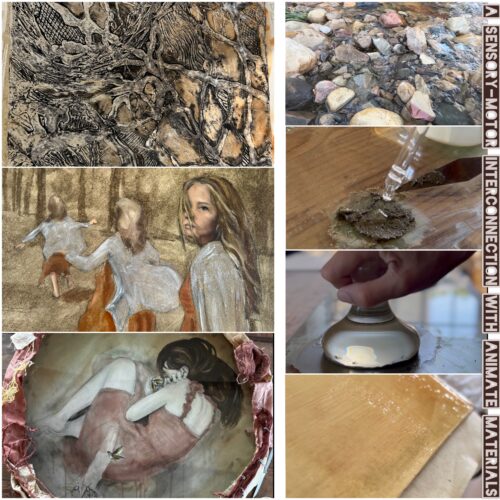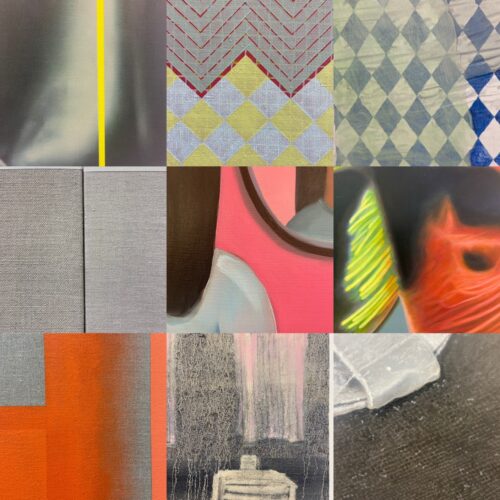
Caulfield & Hume visit
This is a post from the weareoca.com archive. Information contained within it may now be out of date.
 Here is OCA tutor and art guide Gerald Deslandes with a happy band of OCA students outside Tate Britain, where he ran a study visit to see the Caulfield and Hume exhibition the other day.
Here is OCA tutor and art guide Gerald Deslandes with a happy band of OCA students outside Tate Britain, where he ran a study visit to see the Caulfield and Hume exhibition the other day.
‘Patrick Caulfield’s fabulous retrospective of works from 1960 to his untimely death in 2005 is one of the must-see shows of the year. What was interesting was the comparison between Caulfield’s use of bold outlines and flat colours as well as his exploration of the area between figuration and abstraction and the equally enigmatic but more self-consciously knowing works by Gary Hume.
Both artists are ‘minimal’ in the sense that they deliberately use a limited range of visual ideas. In addition both are interested in combining geometric abstraction with imagery that is banal, kitsch or vulgar. This is apparent in Patrick Caulfield’s portrayal of ‘ethnic’ restaurants with their overblown Moorish interiors and Spanish bull’s heads or in his use of saccharine colours to depict delicately painted roses, fruit or jewellery. It is also true of Gary Hume’s decorative portrayal of English songbirds or his placing of a simple blob of painted bronze on top of a larger one to indicate a snowman. Like Caulfield, Hume treads a narrow path between describing the world and making abstract shapes. This ambiguity is apparent in early works such as Barn Door, whose simple construction pokes fun at the rigidity of geometric abstraction in much the same way as the flaccid shapes and flesh colours of his later works evoke landscapes, flowers or the human body.
Yet whereas Caulfield is consistently sharp, witty and inventive – as in his interruption of a grid of windows with an open pane in Window at Night – Gary Hume’s elliptical post-modernism sometimes verges on the clever-clever. This is particularly true of his portraits of celebrities where, for example, he fuses Michael Jackson’s nostrils and Kate Moss’s face in his ironically titled painting Beautiful. Here, as elsewhere, both images are almost illegible since they are painted on slippery aluminium under thick areas of gloss paint. Their juxtaposition of contrasting colours and paint surfaces make them even more difficult to read spatially against the surface behind them. This led to some fascinating discussions amongst the group about exactly how they had been made.
One of the bonuses of our visit was an opportunity to see the recent re-hang of the collection. This has been hung chronologically rather than thematically for the first time since the non-British collections were transferred at the time of the opening of Tate Modern. The re-arrangement has led to some interesting juxtapositions such as the pairing of an 18th Century portrait of the actress Mrs Yates in the role of The Orphan from Chinaby the little known Tilly Kettle with contemporary paintings of the British India by Johan Zoffany.
Our group concentrated on the most recent works in the collection. This provided a chance to do some drawings and to enjoy works such as the Chapman brothers’ installation of sculptures by imaginary ‘African’ tribes such as the ‘Camgi B’, which is ‘BigMac’ in reverse. The visit also gave us a chance to compare Gary Hume’s paintings with sculptures by William Tucker from the early sixties – the period when Caulfield was developing his style. The comparison seemed particularly revealing since Tucker, like Hume, uses simple shapes and nursery colours in his sculptures, which resemble not so much the pared-down works of other minimalists as the toys and rattles in a baby’s pram. All in all it was a useful reminder that one of the origins of what we now think of as ‘postmodernism’ was the crisis of representation explored by Hockney, Kitaj, Tilson and others in the sixties. Needless to say, one of the most important members of the group was Caulfield himself.’
Photo by Siegfried Ip and drawing from Howard Andrews’ sketchbook






I saw the exhibition last week and really enjoyed it – a very ‘generous’ (space wise) display. Could somebody explain to me though the significance of Gary Hume’s ‘Anxiety and the Horse. Angela Merkel’ – a lot of green with a yellow lemon? Where is Merkel?
Thanks for this study visit report. I am studying textiles but get to a lot of exhibitions more generally. I went to see the works by Caulfield and Hume when I was in London last week. I really enjoyed the Caulfield, especially work like ‘selected grapes’ I must confess I struggled with the Hume exhibition. I am glad a went and several of the images have stayed with me but I had trouble getting an understanding of the work. Your report was very helpful
To paraphrase one reviewer’s comment, Hume is commenting on modern politicians who act like they are sucking lemons. Maybe Hume sees his subject as a sour puss.